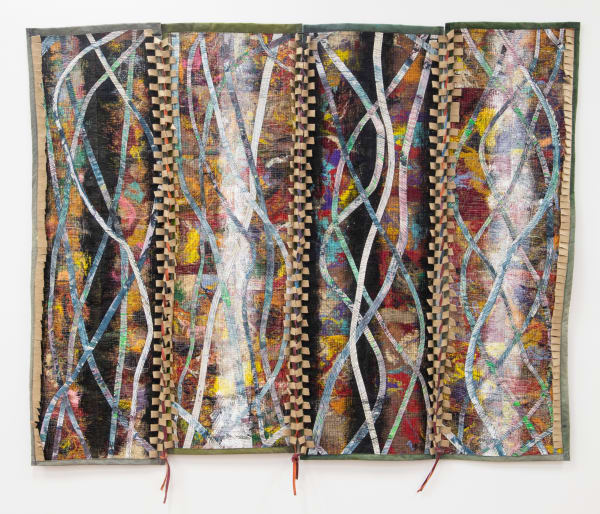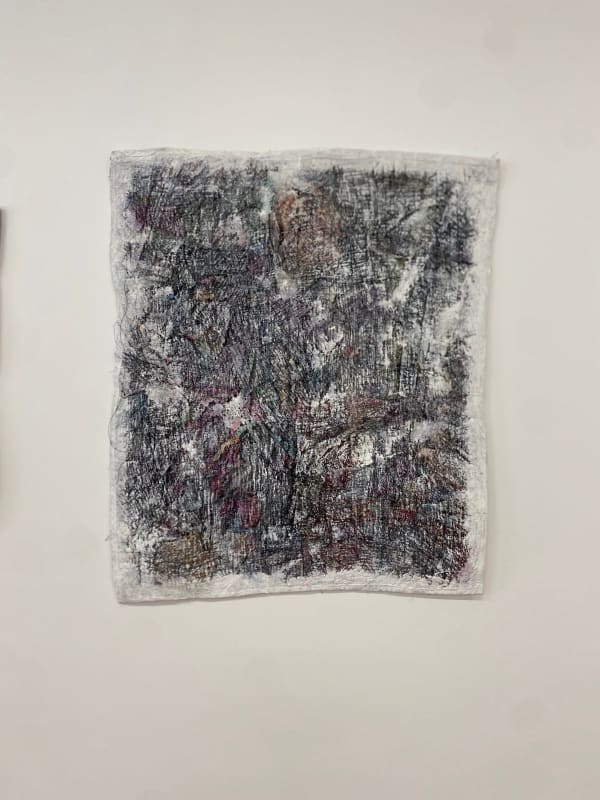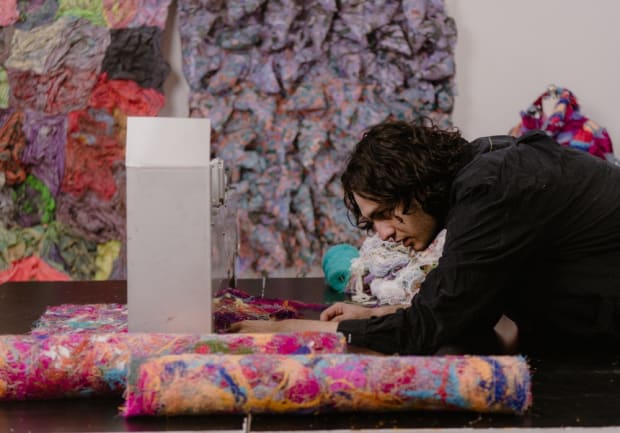-

-
Jordan GogosTime Machine, 2024mixed media with Greek & Australian made acrylic & fabric paints1.75 x 5 m
-
Time Machine certainly references the cultural and familial timelines breeched by his work, it also resonates within a humorous Austin Powers world, filled with campy playacting, dressing up and double entendre.
-
-
‘At the heart of Gogos’ treatment of cloth is a rethinking of age-old techniques such as embroidery, felting and, for the first time, weaving. His textiles push the boundaries of traditional practices, using contemporary materials in historical process. Fracturing time.’
-
-

-
Jordan GogosMirror Image, My Tees, 2024cotton & hessian with Greek & Australian made acrylic & fabric paints350 x 63 cm
-
Time Machine.
By Simeran Maxwell, Curator of Contemporary Art, National Gallery of Australia
Jordan Gogos’ most recent body of work, exhibited in Time Machine, is deeply personal. As an artist, fashion and industrial designer, his practice has always been extremely multifaceted. My first interaction with Gogos was through his bold and adventurous contemporary interpretation of art clothes, a term initially popularised in Australia in the late 1970s and early 1980s. I quickly realised that his playful and thoughtful exploration of textile processes also extended into his visual art works. And during an early studio visit, I discussed his work while seated in his elegant metal furniture.As a textile artist and fashion designer Gogos has, to date, separated these two facets of his practice. While he applies many of the same methodologies to his treatment of fabric–heavy embroidery, felting and the use of recycled materials–his garments remain garments, and his textile art remains… well, art. However, with this latest group of works, Gogos has blended all his skills. Several works include garments, such as the cheeky underpants in Soccer, Balls and the bespoke blazers that have become synonymous with his fashion label Iordanes Spyridon Gogos in Self Portrait: My Life In Parts. Mirror Image: My Tees uses layered deadstock T-shirts.
At the heart of Gogos’ treatment of cloth is a rethinking of age-old techniques such as embroidery, felting and, for the first time, weaving. His textiles push the boundaries of traditional practices, using contemporary materials in historical process. Fracturing time.
Especially with the multi-panelled works, such as Whiplash and Time Machine, Gogos layers processes. Loose threads are compressed, fabric is painted, then embroidered, then stitched into felt and then pleated. Within these works Gogos embeds not only facets of textile history, but also his own personal history.
Gogos has always relied on recycled material, initially for reasons of cost, later from concerns about the environmental impact of the fashion industry. Here he has used Greek textiles that belonged to his yiayia. These fragments of cloth form a deep connection to his family and his culture. Before embedding the fabric in his work, they only had a childhood, a family worth, whereas now they form part of his present-day artistic self. Channelled through his sewing, Gogos turns old memories into the present-day reality, like a time machine.
For the first time since he began working in textiles, Gogos has incorporated elements of his industrial design practice. The sculptural work, Self Portrait: My Life In Parts sees him return to welding metal, this time found objects from his family backyard, where he also made this work. The sculpture acts as a perfect companion to the textile works where the fabrics used are so closely associated to his maternal family and the women in his life. In contrast the found metal objects all belonged to his grandfather. This self-portrait is then clothed in traditional menswear made from fabrics sourced from his grandmother, thus depicting both his feminine and masculine sides.
Another new element running throughout this group of works is paint. Once again, Gogos blends Greek and Australian cultures by choosing paint with Australian sounding names such as ‘gumnut’ and ‘true blue’ with distinctive paint pigments sourced on a recent trip to Greece. What may have started as a personal secret again hidden in the literal fabric of these works, becomes a surprising exploration of textural differences in paint. As Gogos describes it, the oily smoothness of the Australian paints contrasts oddly with the weightiness of the Greek pigments, their ‘crustiness, like mud’ so ‘physically different’ from the Australian paint.
For Gogos, another parallel timeline along which his work and personal ethos sits is the queer coded language of camp. While the exhibition title, Time Machine certainly references the cultural and familial timelines breeched by his work, it also resonates within a humorous Austin Powers world, filled with campy playacting, dressing up and double entendre. This playfulness which speaks to his personality, is something often judged to be at odds with the seriousness of art making. Yet Gogos’ work certainly fits within the lineage of queer Australian artists such as Peter Tully (1946–1992) whose work similarly bridged the gap between art and fashion, camp and serious art. Tully would certainly have laughed at the title Soccer … Balls attached to an enlarged soccer ball decorated with a pair of camouflaged tighty whities.
-
 Portrait by Jiwon Kim for Broadsheet and National Gallery of Australia.
Portrait by Jiwon Kim for Broadsheet and National Gallery of Australia.













